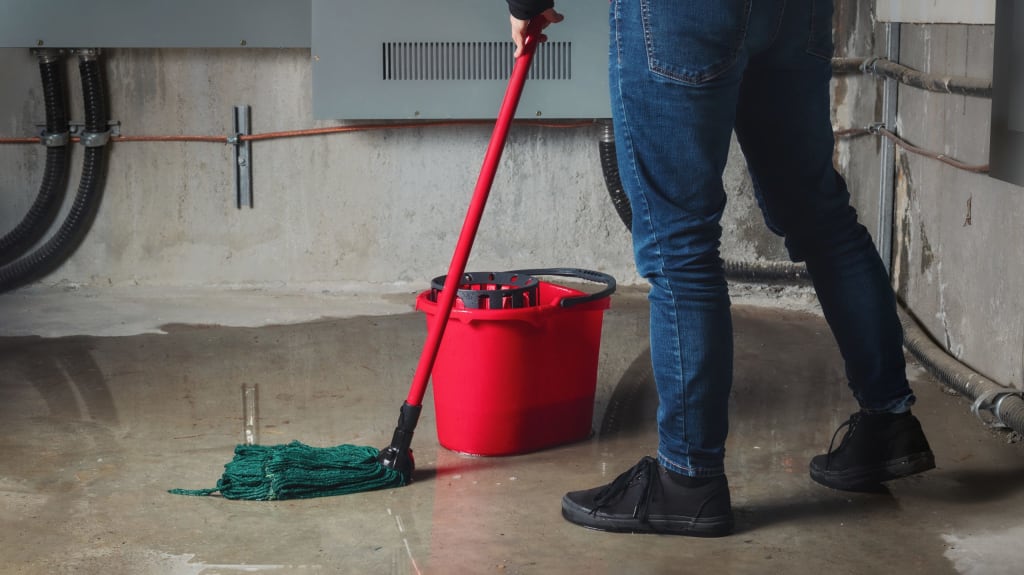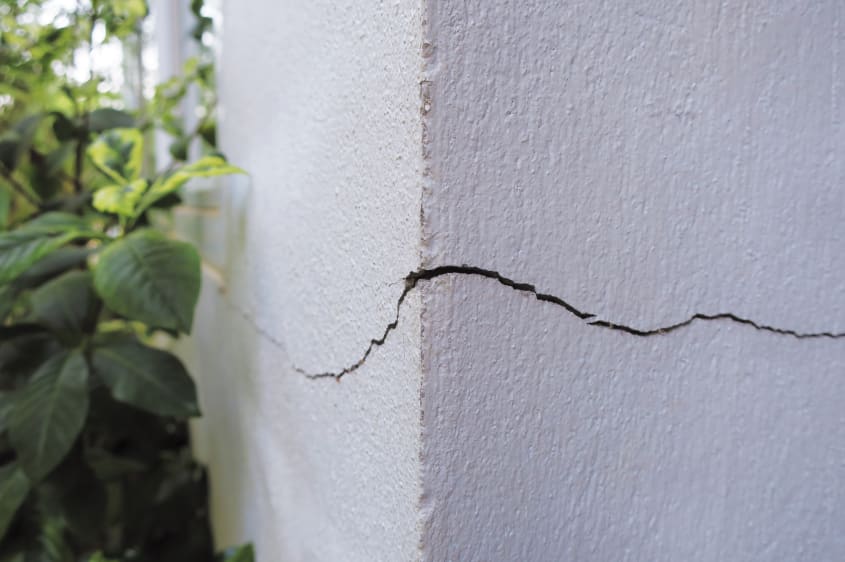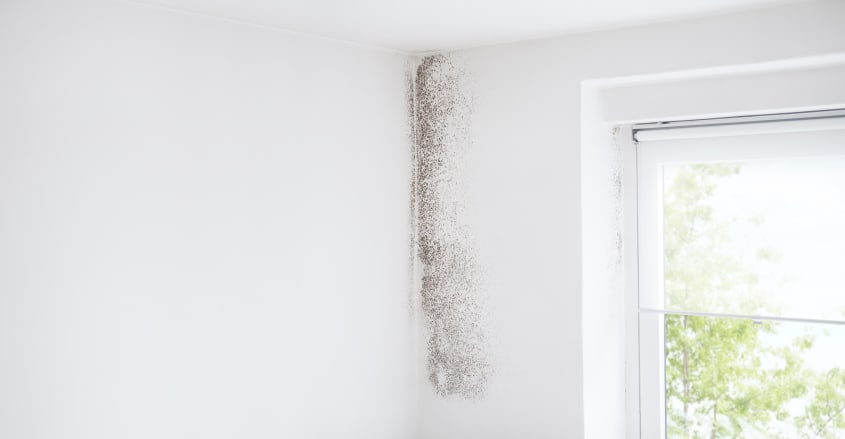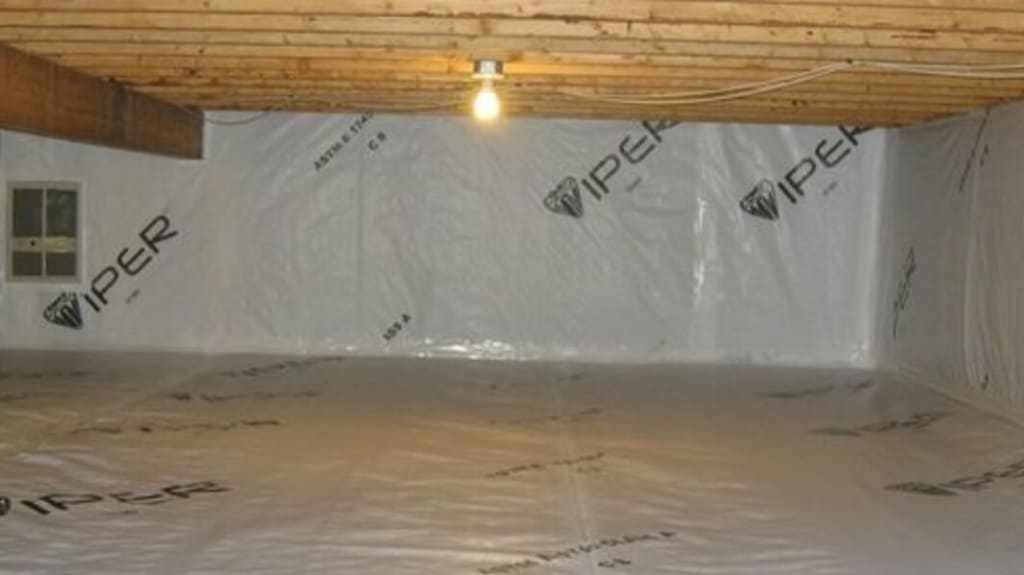Whether you have water infiltration through cracks in the foundation, basement floor, roof, exterior siding or windows, it’s recommended to act quickly. After fire, water is a building’s worst enemy.
Costs are usually minimal if the issue is taken seriously from the get-go as damage caused by prolonged exposure to moisture isn’t given a chance to develop. We’re talking about mould and rot. However, ignoring the problem, either through negligence or because it’s out of sight, out of mind, can cause damage to quickly gain a foothold.
It only takes a few weeks for mould to form and start to spread. If you decide to save money and not deal with it right away, you may find yourself stuck with a higher bill a few months down the road because the problem won’t go away by itself. The longer you wait, the more it may end up costing you.
Consequences of water infiltration
Water infiltration can leave a wide range of issues in its wake, including:
Mould, fungi and bacteria
Effects on occupants’ health
Weakened building structure
Weakened insulating ability of building envelope
Depreciated property value
Possibility of legal action for hidden defects not declared to a potential buyer
A mould-free home with no water infiltration is healthier and safer. It provides increased comfort to its residents and offers superior energy efficiency that protects the property value.
What to do in the event of flooding (house, basement, cellar…)
Flooding and heavy rain pose serious risks to a home’s structure, especially the basement, which is often the first place hit by water infiltration. We saw this during Tropical Storm Debby in August 2024. Prompt action is needed to recover items stored there and, above all, minimize the damage to your property.
First, you need to make sure that the area is safe in the presence of live electrical wires. The electricity and gas should be shut off. Then remove any standing water as fast as possible. Use a pump, buckets or water vacuum to get the job done.
Inspect and assess water damage
Have you successfully removed most of the water from your flooded basement?
You now have to inspect the premises and assess the extent of the damage. Check the structure, walls, floors, as well as belongings, to identify what can and cannot be saved. Throw out anything that has absorbed moisture, because mould and long-term health problems may develop.
William Perreault, Operations and Technical Advice Director at Desjardins Insurance, says when flooding happens, it’s important to distinguish porous from non-porous items. “Non-porous goods resist moisture and are usually easy to recover. Knowing which is which will help you to better manage the damage and preserve your valuable items.”
Porous goods: wooden furniture, carpets, foam mattresses, paper, etc. Non-porous goods: metal furniture, kitchen appliances, plastic, tile, etc.
It’ll be hard to keep porous goods that have come into contact with water while non-porous goods can be cleaned with household detergent. Plan to fully dry all items to prevent the formation of rust.
Dry surfaces
Next move on to dry all affected surfaces: walls, floors and furniture. Make sure to keep the windows closed to avoid exterior moisture from creeping in and slowing down the whole process. Fans and dehumidifiers can speed up the drying.
Disinfect to prevent mould
After removing water and drying all surfaces, it’s recommended to clean everywhere to prevent mould formation. This will get rid of bacteria that threatens to develop and that could lead to more serious issues if not dealt with appropriately.
Use a disinfectant solution on all items that were in direct contact with water. You ensure a healthier environment by doing some preventive cleaning and can lower your chances of experiencing future mould-related complications.
Find out what your insurance covers
As you survey the water damage in your home, contact your insurance company to confirm if the damage is covered. Some companies don’t insure for water-related losses, except in the event of broken plumbing. It’s essential to review the details of your insurance policy to know exclusions and coverage that apply in your situation.
N.B. Two common situations can affect your insurance: overflowing watercourses and sewer backup. We’ll explain the distinction between these types of loss during a claim.
Melting snow can also enter through the roof in the spring and damage your walls, furniture, electronics and floors. In this case, you’re protected only if you’ve taken out coverage for this type of water damage.
Generally, if water infiltration comes from the roof or floor, repair costs won’t be covered unless you have this additional coverage. This is also the case for issues related to sewer backup or heavy rain (like we witnessed with the Debby flooding).
William Perreault recommends properly documenting your file when such an event occurs, as well as taking photos and/or videos of the damage and each item you plan to throw out. You’ll also find information on the Desjardins website about how to file a home insurance claim:
Follow the steps carefully to ensure your claim is properly processed and you receive the compensation to which you’re entitled.
Call your insurer directly if you have questions or need additional advice. Your agent will provide you with the specific details of your coverage, your available options and tell you what steps to take.
Call in the professionals
In some cases, a professional team will be needed to clean up a water damaged basement. Contact a disaster restoration specialist if the damage is severe and you see signs of mould. RenoAssistance Verified Contractors can help: they have the necessary tools and expertise to repair your home.
Reminder: RenoAssistance is not a post-disaster company but can restore and renovate your space after an extreme weather event. Make sure to find out if repairs are covered by your insurance company before starting any work.

Thinking of renovating?
See our article to get more details on the steps to follow after flooding or a loss. Read the EspaceProprio blog to learn specific tips to manage humidity in the basement.
How to spot water infiltration
While flooding is visible and apparent, we shouldn’t underestimate water infiltration, less obvious, that can seep behind walls and pass unnoticed. Here are some signs that your home has likely fallen victim to water infiltration:
Presence of abnormal condensation behind windows
Appearance of mould stains at the bottom of walls or on the ceiling
Accumulation of water on the floor
Presence of bad smells (musty, mildew)
Swelling paint or damp walls under windows
Traces of water on the ceiling
Visible cracks in the foundation or concrete slab
Brittle brick joints
Swelling brick or masonry wall (bulging)
Damaged roof covering
Warped wood flooring
Mould marks on the plywood in your attic
How to identify the source of infiltration?
It’s not always easy to identify the source of water infiltration. Pinpointing its source can be like taking a shot in the dark. Although at first glance it may seem unusual, water found in the basement can be coming in from the roof. Indeed, water may be taking an unexpected path through the attic and walls. The services of a building expert are sometimes necessary as they have the proper equipment to detect water infiltration using thermography.
A thermographic camera is a device that recognizes heat signatures on the surface of various materials. It can therefore be used to identify areas where there may be air infiltration and, by extension, potential water infiltration. Anybody can use a thermographic camera. However, it’s recommended to seek expert advice from someone with the ability to interpret what’s normal and what should be investigated further.

When health alarm bells go off
According to Health Canada, the presence of invisible mould can cause symptoms such as eye, nose and throat irritation. Other symptoms may include runny nose, sinus congestion, wheezing, coughing, increased frequency and severity of asthma attacks, chronic fatigue and headaches.
Common causes of water infiltration
There are many ways that water can find its way into your home. Some of them include:
Cracks in the foundation or concrete slab
Defective or clogged French drain (roots, sand, earth or iron ochre)
Capillary action (when foundation walls act like sponges and absorb water when too much accumulates around them)
Defective sump pump
Sewer backup
Poorly installed windows
Ineffective exterior siding
Dried out caulking and brick joints
Damaged roof
Detached flashings
Heavy rainfall causing flooding
Our foundations experience a lot of stress with freezing and thawing. If there are cracks in the foundation, freezing and thawing periods will only aggravate the situation. Your foundation will no longer be able to keep out water accumulating in the ground, which will be able to penetrate through your basement walls. Beware if your lot has a negative slope toward the house or if your eavestroughs drain close to the foundation. There’s an increased risk of problems developing since water is directed toward the walls of your home.
How to protect your home from water infiltration
Several strategies can be implemented to protect your home from these various sources of water infiltration.
Check the French drain
Is your French drain more than 25 years old? It’s likely not as efficient as it once was. If you’re wondering how good it still works, you should at least schedule an inspection or replace it completely if you have the means. If water collecting around the foundation is the cause of your infiltration, changing the French drain could fix the issue.


Thinking of renovating?
Install a waterproofing membrane
A specialized contractor can also install a new waterproofing membrane on your foundation when you get a new French drain put in. This membrane will play a starring role as your last line of defence when too much water accumulates around your home. It can act as a protective cloak to keep your foundation dry, regardless of how much water builds up.
Caulk your doors and windows
Damaging water infiltration is not always caused by huge amounts of water. The constant infiltration of small amounts of water can have just as serious an impact over time. Indeed, this type of infiltration can be even worse because it remains unchecked longer.
The problem could therefore persist for months or even years before the damage is noticed. It’s also possible that caulking joints are no longer as effective as they once were and you’ll have to replace your windows.

Check exterior cladding for leaks
Inspect your brick joints and schedule repairs if any are damaged to prevent bulging that develops from water accumulating behind the brick. For other types of exterior cladding, simply confirm that the various pieces still fit neatly on top of each other, to prevent any water access.

What to do if you’re dealing with water infiltration, contaminants and mould?
Decontaminate areas with mould
It’s important to ask the experts to take the lead on a decontamination project to effectively and efficiently prevent the spread of any traces of contaminants. It’s not enough to simply sand and get rid of any affected pieces, since mould can become airborne. Everything must be removed and decontaminated using specialized products.
You can go ahead and remove it yourself if the affected area is small (less than 1 m2 per area) and mould is not black or on porous surfaces. See our article for all the details: Decontaminating mould: Four steps to follow.

Install an integrated dehumidification system
We’ve heard how mould and contaminants love humidity. That’s why it’s more likely to be found in dark, damp places than in dry, well-lit ones.
By installing an integrated dehumidifier, you’ll never have to worry about making sure it’s on or remembering to empty it again. An integrated system turns on automatically when the humidity rate is too high and empties itself. It helps keep mould at bay by maintaining a drier environment.
Ensure suitable ventilation where necessary
Proper ventilation can prevent many issues from arising. Keep in mind that ventilation won’t get rid of the problem if mould and contaminants are already present. However, it can help prevent its future spread and development.
Ventilation won’t be enough if mould rears its ugly head. It can damage construction materials, compromise a home’s structural integrity and require extensive repairs.
All contaminated materials should be completely removed to prevent mould from spreading, possibly including partitions and floors. Demolishing and replacing walls may be necessary to guarantee that mould is completely eliminated. We repeat: using a professional can make your life a lot easier if you need a specific damage assessment and proper restoration.

Inspect your roof each season
Check that shingles are all in good condition and don’t curl upwards. If you notice some are looking worn, that means they’ve passed their lifespan. It’s time to replace them as your roof is at risk of water infiltration.
Another vital chore: regularly empty the eavestroughs. Clogged gutters lead to drainage problems and can result in water occasionally flowing onto the roof. Eavestroughs must be kept clear of debris such as leaves and branches so that water can properly drain.

Finding a good contractor to protect your home
At RenoAssistance, we can recommend good contractors in your area who can help prevent water infiltration in your home or carry out restoration work. Get in touch with us today by filling out our form.
Find a contractorPrevention is key: ideas to consider acting on
Faced with a changing climate and the risk of more extreme weather events, it’s becoming critical to rethink the design of our homes, possibly even our cities. There are many issues (and actions) worth exploring as we work to strengthen the resiliency of our living spaces and better prepare for future challenges. A couple ideas to incorporate include:
Choose the right basement floor
A key player in managing risks is your choice of basement floor. Water-resistant materials, tile or waterproof concrete, offer additional protection when compared to more susceptible materials like wood or carpet.
Raise furniture off the floor
Opting for furniture with legs or raised in the basement and on the main floor will surely help limit issues in the event of minor flooding. It will make cleaning up a lot easier and limit material losses.
To find out more about buying a home in a flood zone, read our online article on the DuProprio.com blog.
Have questions about work that needs to be done at your place? RenoAssistance Renovation Advisors are here to accompany you, advise you and provide you with all the tools you need.
Talk to a renovation advisor







